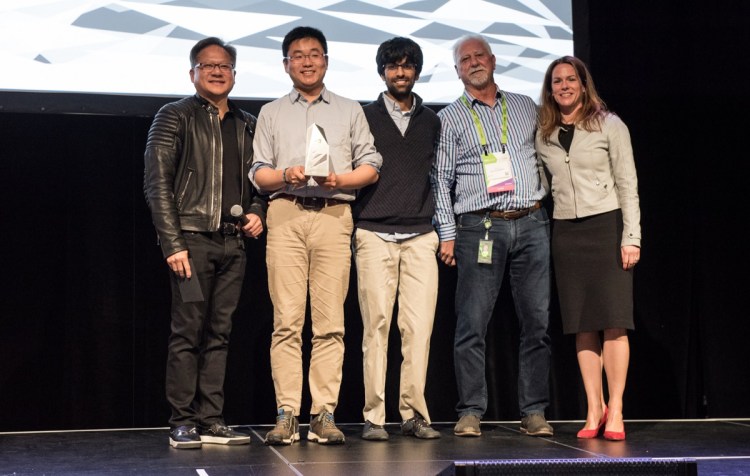Watch all the Transform 2020 sessions on-demand here.
Nvidia picked its Inception program winners for the best artificial intelligence startups during the company’s GTC 2018 event in San Jose California. The winners are Subtle Medical, AiFi, and Kinema Systems.
These startups are the ones that Nvidia hopes will change the world and tap the computing power of Nvidia’s graphics processing unit (GPU) and AI processors. The three winners will split a $1 million prize.
More than 200 companies applied for the contest, and I saw 12 of them present a couple of weeks ago in a Shark Tank-styled event, as did Nvidia CEO Jensen Huang, a panel of four judges, and various sponsors. To date, there are 2,800 startups in the Nvidia inception program — a sign of the size of the AI and data science startup community.
The top categories include IT services, automotive, healthcare, smart cities, manufacturing, robotics, fintech, and others. Subtle Medical was in the healthcare category. AiFi was in enterprise, and Kinema Systems was in autonomous vehicles.
June 5th: The AI Audit in NYC
Join us next week in NYC to engage with top executive leaders, delving into strategies for auditing AI models to ensure fairness, optimal performance, and ethical compliance across diverse organizations. Secure your attendance for this exclusive invite-only event.
“We are happy to introduce VCs to the best companies in this program,” said Jeff Herbst, vice president of business development at Nvidia.
The judges included Herbst; Tammy Kiely, head of semiconductor investment banking practice at Goldman Sachs; Steve Wymer from Fidelity Investments; and Jaimin Rangwalla of Coatue Management.
Last year’s batch included 14 finalists who had raised $28 million from investors before the Inception event. A full year later, those 14 companies have raised $200 million.
Here’s our profiles of the finalists and winners.
Subtle Medical
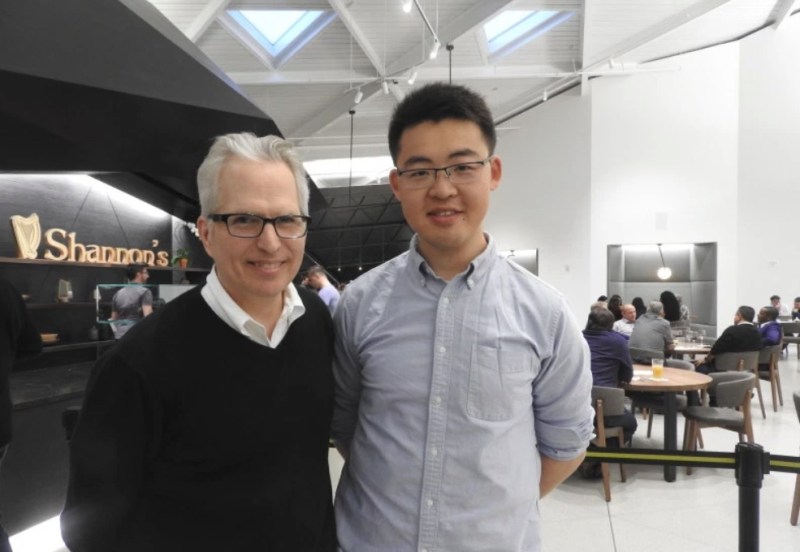
Above: The founders of Subtle Medical. Greg Zaharchuk (left) and Enhao Gong.
Enhao Gong, cofounder of Subtle Medical, believes that medical imaging tests — such as magnetic resonance imaging (MRI) and positron emission tomography (PET) — take too long and are too expensive. Each test takes about 45 minutes, which hasn’t really changed in years, and costs around $2,000. This high price tag is partly because the test takes so long that it can be very difficult to get enough people through in a day to help defray the heavy fixed costs.
Silicon Valley startup Subtle Medical has come up with a way to speed MRIs up by two to four times, while maintaining image quality. It does that with AI, which can replace traditional slow and costly exams using deep learning neural networks.
The technology also leads to shorter duration and lower dosage of radiation in PET exams, which brings its own health benefits.
“We can make it faster, cheaper, safer, and smarter,” Gong said. “We believe an AI-empowered engine workflow will result in more usage.”
Cofounder Greg Zaharchuk said, “A lot of people can’t stand a 45-minute exam — patients who are claustrophobic or pediatric patients. Our goal is to reduce the time by two to four times. We get better diagnostic quality and more competent diagnosis. And we allow people to scan many more patients per day and reduce the radiation dose.” Zaharchuk noted that traditional “contrast agents” aimed at making the MRI images clearer carry their own risks.
“We think that Subtle Medical will be a disruptive force in radiology,” Zaharchuk said.
Importantly, Subtle Medical is not seeking to replace radiologists, which are only about 10 percent of the cost, Gong said.
Subtle Medical was founded in August 2017 and has fewer than 15 people. It has raised $1.1 million from Data Collective, Zhen Fund, Baidu Ventures, Tsingyuan Venture, and Wisemont Capital.
AiFi

Above: The leaders of AiFi: Kaushal Patel (left) and Steve Gu on right.
AiFi wants to get retail stores ready for the future. It is following in the footsteps of Amazon Go, a small retail store in Seattle where you can check out your purchases automatically, without waiting in line. While the Amazon store is custom-built, AiFi wants to create a solution that scales and is more flexible.
“Our solution works both for the mom-and-pop store or the giant,” said AiFi CEO Steve Gu. “Our first store is 50 times bigger than Amazon Go.”
AiFi works by building a simulation of a store. It then uses that simulation to train its AI network so it can use multiple cameras to monitor shoppers for theft or check them out immediately as they put things into their bags and exit the store. Gu said that big stores could save $3 million in reduced labor costs alone.
“We are building AI on the edge,” Gu said. “Our superior algorithms can recognize over 15 different shopping activities. We can track 500 people and can recognize over 50,000 SKU items.”
The company has a fully functional test store at about 725 square feet, and it is working on a much bigger pilot store with a customer.
AiFi was founded in 2016 and has fewer than 30 people. The company has raised $4 million from Stanford StartX, Plug & Play, Greylock, Amino Ventures, Oriza Ventures, CSC Ventures, and AngelPlus Ventures.
Kinema Systems
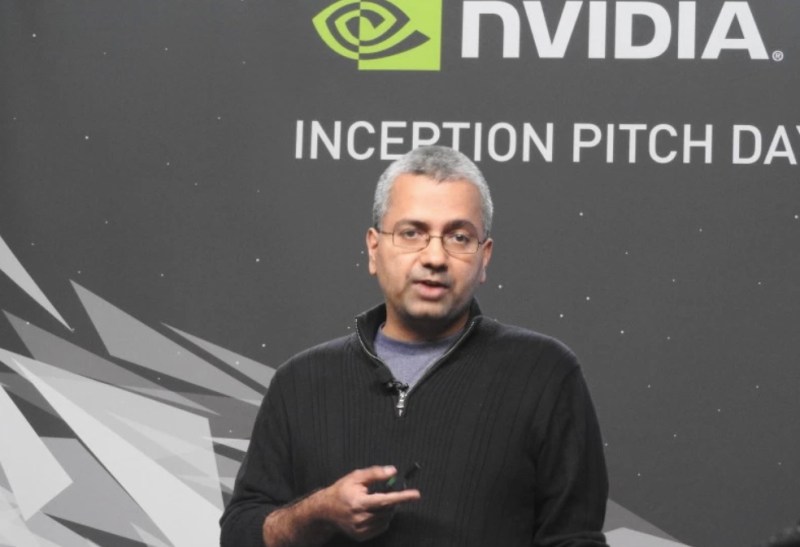
Above: Sachin Chitta, CEO of Kinema Systems.
Sachin Chitta, CEO of Kinema Systems, started his company to get robots to do what is a very simple task from a human perspective: pick up boxes and put them on conveyor belts. People are good at this kind of intuitive work, but machines are not. Kinema had to develop sophisticated 3D vision systems and deep learning neural networks to create robots that were smart enough to do it.
Kinema Pick is software designed to pick and “depalletize” boxes for logistics, manufacturing, and shipping uses. It has 3D vision to discern the sizes and shapes of boxes — which vary by the millions. The software is installed on a PC with a GPU, and it integrates with Kinema’s 3D/2D camera. What’s good about this, Chitta said, is that it is a lot more flexible than prior robotic systems and enables robots to move around in their own work areas without being controlled by humans. It can also do the work at a high speed.
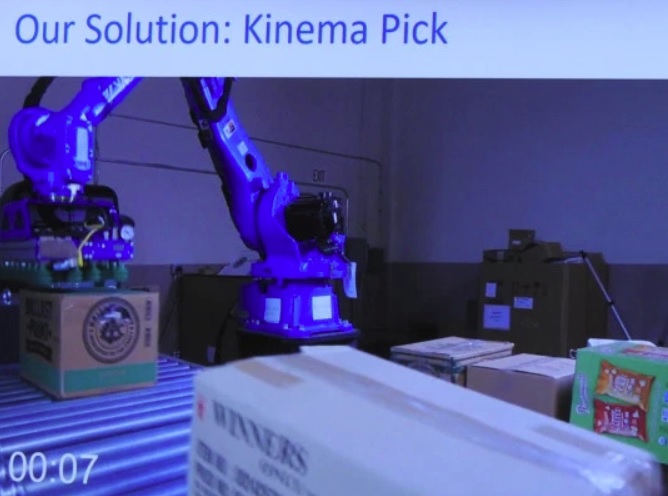
Above: Kinema Systems can power a warehouse robot.
“We do fast, real-time inferencing for locating boxes,” Chitta said. “And we know there are millions of types of boxes in the world.”
The company was founded in June 2015 and currently has fewer than five people. It has raised $1.8 million from Formation 8, to date. The founders came from Willow Garage, which developed an open source robotic operating system, and SRI, the Silicon Valley research lab that also did pioneering work in AI and robotics. The camera and software sell for about $50,000.
Rivals include Cognex, Omron Adept Technologies, and others. Chitta said his company is very focused on navigating 3D environments, and the software works with off-the-shelf robots.
Cambridge Bio-Augmentation Systems

Above: Emil Hewage is CEO of Cambridge Bio-Augmentation Systems.
Emil Hewage, cofounder and CEO of Cambridge Bio-Augmentation Systems, is creating neural interfaces for the next generation of AI-powered health care. The company has initially focused on helping people who have lost limbs through a new field dubbed “neuro engineering.”
It is doing so by creating an open standard hardware and software interface for the nervous system. Hewage things of it as a USB port for the body.
“When we think about edge computing, we think about how can we connect AI through the nervous system to the body, and how can we change people’s lives,” Hewage said. “It’s very difficult, but it’s worth solving.”
Hewage said he thinks of the nervous system as “our body’s internet.”
“If your body loses control of the nervous system, it loses its ability to control organs or limbs,” he said. “What is happening in nerve pathways before critical system failures, like heart failure, or an influx of blood sugar?”
CrowdAI

You might think mapping technologies such as Google Maps or Apple Maps have solved the problem of providing satellite-based maps for the world. But CrowdAI CEO Devaki Raj said that big opportunities arise when you apply deep learning neural networks to satellite and aerial imagery.
CrowdAI gets access to real-time satellite and aerial imagery and uses AI to automatically detect features such as buildings or roads. It can then provide this information to big companies that need to monitor the status of global infrastructure. This is particularly useful in rural areas or the developing world, where this kind of data isn’t always available and where new construction tends to happen.
It’s also useful in emergency situations. If there’s a flood, for instance, CrowdAI can quickly determine which buildings are underwater or which roads have been wiped out. It can help insurance companies know exactly how much square footage a building occupies.
“What we’re doing is fundamentally deeper,” Raj said. “We deliver actionable insights at a scale and granularity never available before.”

Above: CrowdAI can monitor changes in the globe in real time, like the expansion of a labor camp in North Korea.
CrowdAI can also unearth some disturbing things, such as the growth of the size of a labor camp in North Korea, or which buildings have been destroyed by shelling in Syria. The company charges governments and companies based on the amount of data they use on a country-by-country basis.
The company was founded in May 2016, and it currently has fewer than 15 people. It went through Y Combinator and has raised $2.1 million from SV Angel, AME Cloud Ventures, BoxGroup, Liquid 2 Ventures, Susa Ventures, Compound Ventures, Vy Capital, and Y Combinator. CrowdAI competes with larger companies like Orbital Insights, but Raj said her company specializes in low-resolution imaging on a global scale.
Ghost Robotics
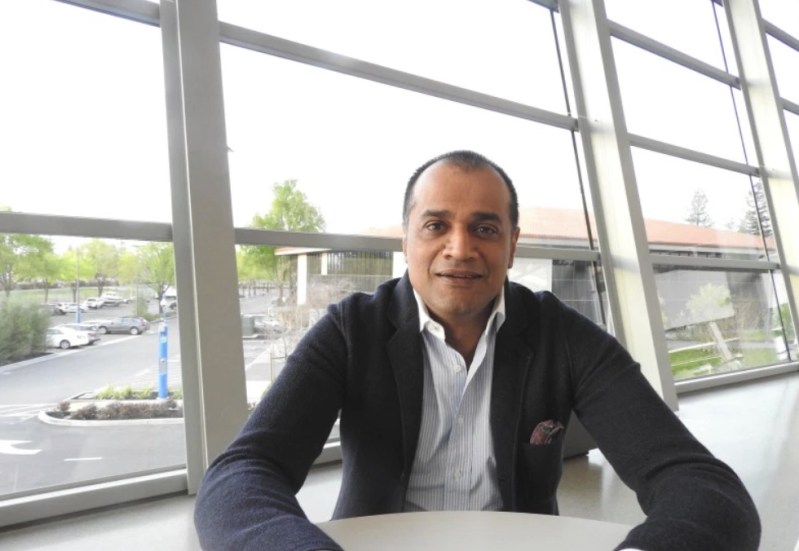
Above: Jiren Parikh, CEO of Ghost Robotics.
Jiren Parikh, CEO of Ghost Robotics, said that legged robots have been around for a couple of decades. But his Philadelphia-based team took some university learning about the complex systems and spun out a startup that is focusing on making robots with legs that can do things like manipulate a door, climb a fence, and accomplish tasks in a very energy-efficient way.
“We took a typical hardware platform, simplified it, made it programmable, made it lightweight, and reduced the cost by 10 times,” Parikh said. “Today’s robots are very complex systems. We believe that software will democratize robots.”
Rivals include Boston Dynamics, which recently showed how one of its dog-like robots could open a door. Ghost Robotics one-upped that as a student programmed one of its robots to climb a chain-link fence. The company hired that student. While other robots take a long time to set up, Parikh said his robots can be up and running in about 20 minutes.
The robots are designed to go over any kind of unstructured terrain, from stairs to rocky paths. The market for these robots could be industrial production or Department of Defense applications.
Each robot sells for about $15,000. The company sold about $300,000 worth of robots last year, and it is shipping a new version this year. It expects a number of enterprise deals to come in late this year.
Ghost Robotics was founded in October 2015. It has raised $800,000 from Brain Robot Capital, Asimov Ventures, CoCoon Ignite, Polis Seed Ventures, 4428 Investments, Prosper Creation, and others.
“We are trying to take something very complex and open it up for innovation,” Parikh said.
